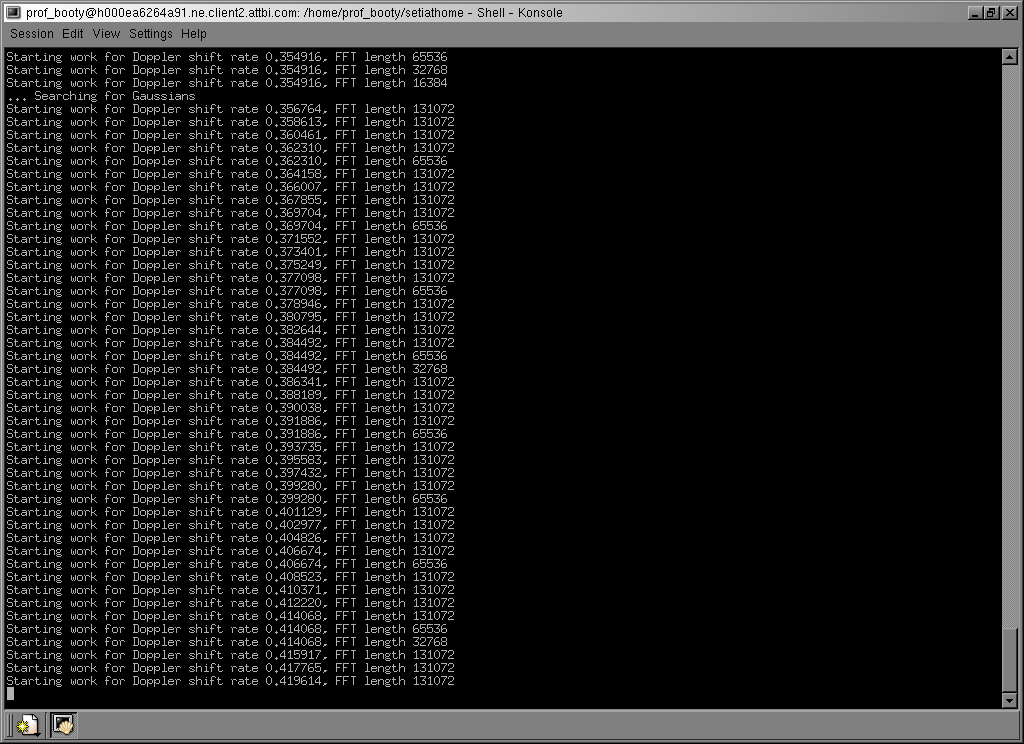05/25/2004:  Technologica
Technologica
Subject: SETI@home news bulletin
From: SETI@home (setiathome@ssl.berkeley.edu)
To: prof_booty@a...
Date: 7:44 AM
Received: (from setiathome@localhost) by philmor.ssl.berkeley.edu (8.9.3p2/8.9.3) id EAA05984
Dear prof_booty:
SETI@home turned five years old on May 17, 2004! Thanks for participating in SETI@home. According to our records, you have processed 5 work units, the most recent on May 12, 2004. Your contribution of computer time is greatly appreciated.
Science News
---------------
Last year, SETI@home was granted 24 hours at the Arecibo observatory to reobserve the best "candidate" locations detected by volunteers running the SETI@home screensaver. We were able to observe 226 points on the sky, including many of the best SETI@home candidates, others found by the SERENDIP project, and some interesting astronomical objects including known planetary systems and external galaxies. We sent the data from these observations to SETI@home volunteers (that means you!), and when the results came back we scanned them for signals similar to the candidates. We expected that, due to random noise, the scores of about 10% of candidates would improve. In fact, no matching signals were found for most candidates and therefore their scores got worse. The exceptions were Gaussian candidates with a wide frequency window; about half of their scores improved, but this is an artifact of the way SETI@home detects Gaussians.
I've been running it on various accounts and computers since 2000, and I don't care what they say on /., this is still original and coolest distributed computing project. Read on for more.
More
Of the other signal types, only one candidate was found whose score improved. It is a Gaussian-type signal with a narrow frequency window. This would normally get us excited, but unfortunately the properties of this particular signal don't seem consistent with it being an ET signal. In a narrow frequency window, we would expect to find Gaussians with low Doppler drift rates (ones whose frequency is not changing rapidly with time). This Gaussian candidate consists of signals whose Doppler drift rates are between 10 and 50 Hz per second. These would drift out of our 125 Hz matching window in a few seconds, so if we had looked at that part of the sky even a few seconds later (in any of our observations of this part of the sky), we wouldn't have found a match. So it's not likely that this is an ET signal. Even so, we'll keep an eye on this spot on the sky.For details of this entire process, see
http://www.planetary.org/html/UPDATES/seti/SETI@home/Update_051704.html
http://setiathome.ssl.berkeley.edu/candidates.html
http://planetary.org/stellarcountdown/index.html
http://setiathome.ssl.berkeley.edu/newsletters/newsletter8.html
http://setiathome.ssl.berkeley.edu/newsletters/newsletter14.html.
What's Next?
------------
The candidates we reobserved came from only the first 2 years of SETI@home
observations, so we've still got a lot of work to do.
Right now, we're identifying a new set of candidates,
and we will request time on the Arecibo telescope to reobserve them.
SETI@home will continue with a new software architecture (BOINC)
and new hardware at Arecibo
(the Arecibo L-band Feed Array, or ALFA, a new multi-beam receiver)
that will perform a comprehensive survey of the sky.
We hope you're as excited as we are about our search for life outside Earth.
Thanks for your continued participation and support.
Dr. David P. Anderson
Project Director, SETI@home
http://setiathome.berkeley.edu
3 Annotations Submitted
Tuesday the 25th of May, some high kid noted:
Wooah, look at all the pretty colors man. This screen saver rocks!
Tuesday the 25th of May, some *nix n00b noted:
no pretty colors...
Wednesday the 26th of May, awiggins noted:
I have said it once, and I will say it again. F linux!


